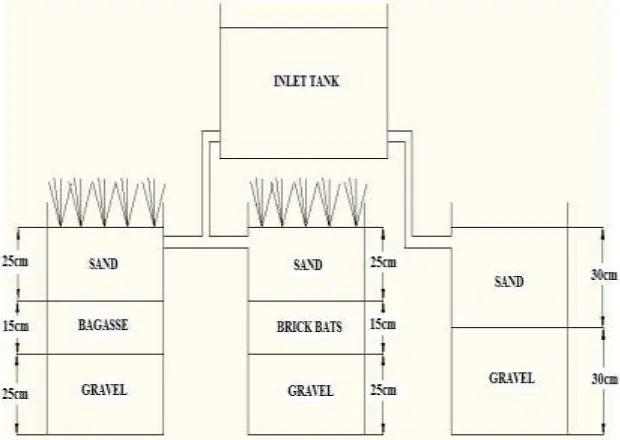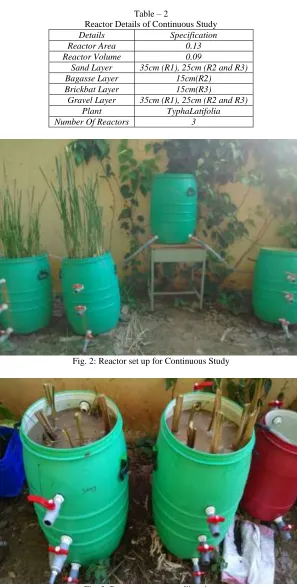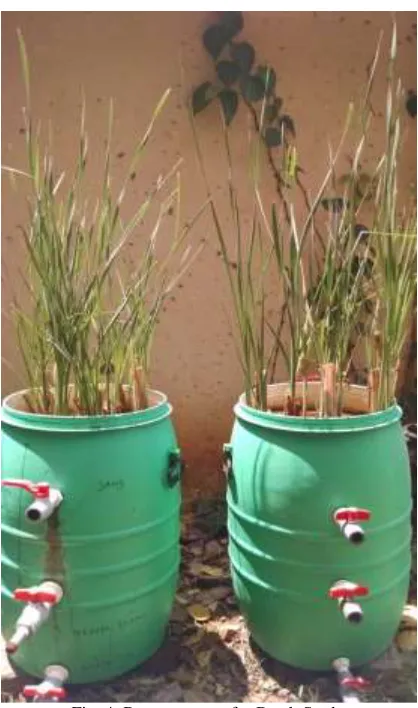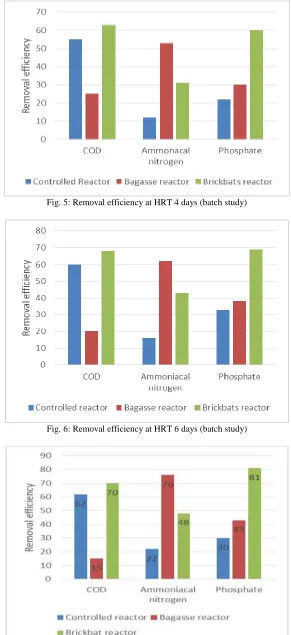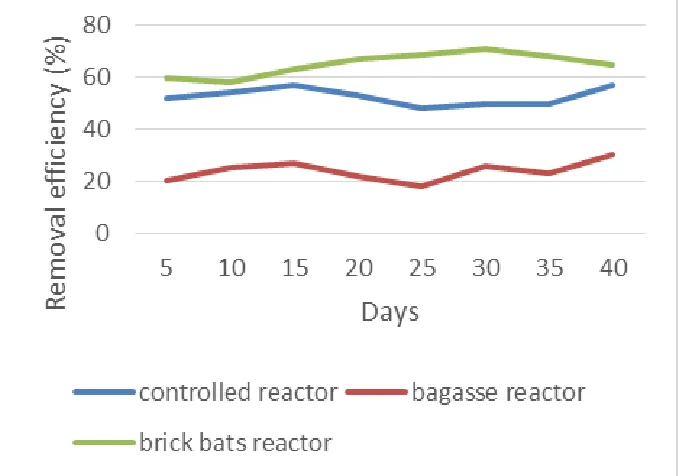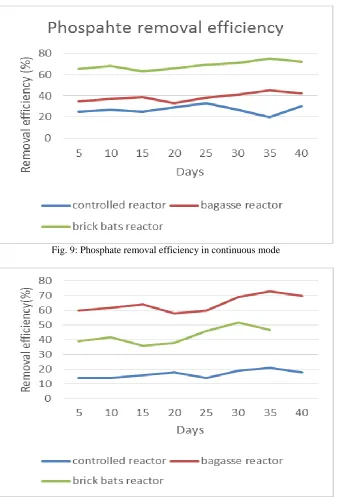Comparison of Nutrient and Organic Removal in
Constructed Wetlands
Abdul Jabbar. M. Ganapathyvenkatasubramanian S.
PG Student Professor Centre for Environmental Studies, Anna University, CEG-
Campus, Chennai-25
Centre for Environmental Studies, Anna University, CEG- Campus, Chennai-25
Abstract
This paper reports the pollutant removal efficiencies of three lab-scale constructed wetland systems treating synthetic grey water. The three systems had identical configurations, each consisting of a vertical flow (VF) constructed wetlands that were filled with organic sugarcane bagasse and brick bats as the main media planted with reed plant typhalatifolia and one controlled system. The primary objective of this study was to remove organics and nutrients present in the greywater. This work is carried out in both batch mode and continuous mode. In batch study, three systems were operated under various HRT of 4,6 and 8 days. In continuous study, wastewater was fed into all systems at flow rate of 15ml/min. The organic carbon (C) content of sugarcane bagasse facilitated denitrification in the bagassewetland and brick bats remove phosphate by adsorption. Overall the better removal efficiency for batch study obtained at HRT 8 days were 70%, 50% and 80% for COD, nitrogen and phosphates in brick reactor. In Continuous study, bagasse reactor removes nitrogen by75% while brick reactor removes both COD and phosphates by 70% and 75% respectively.
Keywords: COD, Vertical Flow (VF), HRT
________________________________________________________________________________________________________
I. INTRODUCTION
The world is experiencing significant growth in human population, and fresh water is becoming a scarce resource. It is therefore essential to reduce surface and groundwater use in all sectors of consumption, to substitute fresh water with alternative water resources and to optimize water use efficiency through reuse options (Zuritaletal.2006). Greywater is all wastewater that is discharged from a house, excluding black water (toilet water). This includes water from bathrooms, laundry and kitchen. Typically, 50-80% of the household wastewater is grey water. Greywater is a reflection of the household activities and its characteristics are strongly dependent on living standards. Dishwashing and laundry detergents are the main sources of phosphorous in greywater. In countries where phosphorous-free detergents are used, these loads are minimal. Kitchen greywater is the main source of nitrogen in domestic greywater, while the lowest levels are generally observed in bathroom and laundry grey water (S.Saumya et al., 2014).The main purpose of greywater recycling is to substitute the precious drinking water in applications which do not require drinking water quality. Non-potable reuse applications include industrial, irrigation, toilet flushing and laundry washing dependent on the technologies utilized in the treatment process. Constructed wetlands technology (Maloszewski et al., 2006) is an environmentally friendly method used to treat waste water of different origins they are natural waste water systems. A variety of treatment process takes place in constructed wetland such as filtration, sedimentation, and biological degradation which together effectively remove the contaminants in waste water. Transformation and removal of pollutants from wastewater occur via numerous interrelated physical, chemical and biological process including biodegradation of organic by bacteria, ammonification-nitrification-denitrification of organic nitrogen by bacteria , uptake of nitrogen and phosphorous by plants, adsorption of phosphorous and release of gaseous products of organic matter into the atmosphere.(Vymazal.,2010). The soluble pollutants are transformed and removed mainly through the process that occurs at the plant surface, plant debris, or filtering media. Constructed wetlands may be categorized according to the various design parameters, but the three most important criteria are hydrology (open water-surface flow and subsurface flow), type of macrophyte growth (emergent, submerged, free-floating) and flow path (horizontal and vertical)
II. MATERIALS AND METHODS
Sugarcane bagasse is obtained from local sugar juice shop around the Chennai city. The bagasse is allowed to dry slightly in sunlight and was chopped into small bits. 90 L water drums are used for reactor setup. To maintain the constant nutrients, synthetic waste water is prepared. In three reactor, two were planted with reed plant Typha latifolia ad one is controlled. The composition of synthetic grey water is shown in table1.
Table – 1
Colgate toothpaste 30 mg Sabeena powder 50 mg Tide washing powder 50 mg Fair and lovely cream 50 mg Parachute hair oil 0.3 ml Sunsilk black shampoo 0.5 ml Lifeboy soap 50 mg
Rim bar 100 mg
Rice 1 g
This work was carried out in two phases. The first phase involves studies in batch mode, while the second phase involves studies in continuous mode.
Batch Study
The study was carried out in three plastic reactors of height 70cm and diameter 40cm in which two reactors were filled with sand, gravel and additional substrate at a depth of 25cm, 25cm and 15cm respectively. Two of the reactors were planted with Typha l atifolia as a reed plant while the other was kept unplanted (control). An influent tank was provided to hold the waste water to be passed into the system and influent was passed through a 1 cm diameter pipe. A flow control valve was used to regulate the flow of water entering the reactor
Continuous Study
For the study of vertical subsurface flow constructed wetlands in continuous mode, three reactors, each of height 70cm and diameter 40cm were set up. Two of the reactors were kept planted while; one was kept as control (unplanted). Two of the reactors planted with typhalatifolia were filled with different media of gravel, sand, and bagasse/bricks while the other was filled with only gravel, sand and soil. An influent tank was provided to hold the wastewater to be passed into the system and the influent was passed through a 1cm diameter pipe. A flow control valve was used to control the flow of water entering the reactor. The setup used for the continuous study is shown in Fig 1
Fig.1 Experimental Setup for Continuous study
III. EXPERIMENTAL SETUP
Table – 2
Reactor Details of Continuous Study Details Specification
Reactor Area 0.13
Reactor Volume 0.09
Sand Layer 35cm (R1), 25cm (R2 and R3)
Bagasse Layer 15cm(R2)
Brickbat Layer 15cm(R3)
Gravel Layer 35cm (R1), 25cm (R2 and R3)
Plant TyphaLatifolia
Number Of Reactors 3
Fig. 2: Reactor set up for Continuous Study
Fig. 4: Reactor set up for Batch Study
IV. RESULTS AND DISCUSSIONS
The performance of constructed wetlands was studied using household grey water. To maintain the steady influent concentration of constituent synthetic grey water was prepared carry out the study. Parameters such as BOD, COD Phosphates and Ammonia nitrogen were all analyzed according to Standard Methods for Estimation of Water and Wastewater, APHA (1998) to determine the initial characteristics of the waste water. The influent constituents and their respective concentration are given in table 3
Table – 3
Characteristics of synthetic grey water
S.NO Parameters (mg/L)
1 BOD 160
2 COD 447
3 AMMONIACAL NITROGEN 2.7
4 PHOSPHATE 13.7
Removal Efficiency in Batch Mode:
Studies at three different hydraulic retention times of 4 days, 6 day and 8 days were carried out. This study was carried out to determine the performance of the constructed wetland in the removal of COD, Ammonia nitrogen and phosphate and the effect of varying HRT. Wastewater was fed into the three systems in which one was controlled and other two were planted. The study was carried out for each HRT in all three systems till stable values were obtained and the performance of planted and unplanted system was compared. The results obtained in the performance of the systems for the removal of concern parameters COD, ammonia nitrogen and phosphate at HRT 4 days, 6days and 8days were shown Fig 5 to Fig 7 respectively.
in the soil or the media bed (Hoffmann et al.,2011). The similar COD treatment trends in the two systems may be due to the aerobic degradation of organic matter.
Fig. 5: Removal efficiency at HRT 4 days (batch study)
Fig. 6: Removal efficiency at HRT 6 days (batch study)
Phosphate removal is governed by sedimentation and adsorption processes. Phosphorous can be removed directly by the uptake of plants or via chemical storage in the sediments. From Fig 5-7, it can be observed that the percentage removal efficiency of phosphate were 22%, 30%, 60% at HRT 4 days and 33%, 38%, 70% at HRT 6 days and 30%, 45%, 80% at HRT 8 days in controlled, bagasse and brick bats reactor respectively. Sakadevan and Bavor (1998) suggested that the principal long term phosphate removal mechanism in constructed wetland system is via the substratum, litter and Aluminium/Iron component. Since sand and gravel layers in subsurface wetlands used in the study do not contain high concentration of these elements, it may be the reason for the phosphate removal being low in controlled and bagasse reactor. Vegetation was not found to be very effective in phosphate removal in the study.
From Fig 5-7, it can be observed that an average removal efficiency of ammonical nitrogen were 22%, 30%, 60% at HRT 4days and 35%, 40%, 70% at HRT 6 days and 30%, 45% and 80% at HRT 8 days in controlled, bagasse reactor and brickbats reactor. It can be observed that the removal nitrogen is mainly due to the plant uptake in the planted system as compared to denitrification that occurs in the unplanted system which occurs under anoxic conditions (Vymazal, 2007). Bagasse reactor removes nitrogen more than brickbats reactor because of external carbon source which enhances the denitrification process in vertical --wetland.
Removal Efficiency in Continuous Mode:
Waste water was fed into the reactors containing different media and plants. This study was carried out to determine the performance of the constructed wetland in the removal of COD, Ammoniacal nitrogen and Phosphate removal and the effect of different media.
Three reactors were used to determine the effect of media on the performance of the wetland. One of the three reactors was filled with gravel and sand while the other two were filled with gravel, soil and bagasse/brickbats. Both the reactors were planted with common plant (typhalatifolia). These reactors were used for determining the effect of media in the treatment process.
The average removal efficiency of COD in the system containing sand, bagasse and brick bats as the media was 50%, 20% and 60% respectively. It can be observed that system containing bricks and unplanted were more efficient when compared to that of bagasse. The COD removal is mainly due to the degradation by microorganism that attaches themselves in the soil or the media bed. It can also be observed that the planted system were more efficient than that of the unplanted systems, which may be due to the oxygen leakage from the plant roots which in the aerobic degradation. The removal of COD, Phosphate and Ammoniacal nitrogen for different media were shown in Fig 4.4 -4.6 respectively.
Fig. 9: Phosphate removal efficiency in continuous mode
Fig. 10: Ammoniacal nitrogen removal efficiency in Continuous mode
Phosphate removal is mainly governed by sedimentation and adsorption processes. The principal long term phosphate removal mechanism in CW is via substratum, litter and Al/Fe component. Since sand and bagasse layer do not contain high concentration of these elements, the efficiency of sand system (25%) and bagasse system (35%) is lower than brick system (65%). Plant biomass uptakes certain amount of phosphate, hence the removal of phosphate is greater in planted system than unplanted.
Nitrogen removal is mainly governed by nitrification, denitrification and ammonification. The average ammonia nitrogen removal in bagasse system (70%) is greater than unplanted (15%) and brick system (40%).
V. CONCLUSIONS
The vertical subsurface flow constructed wetland that was employed in the batch study was efficient for the removal of COD, phosphate and Ammoniacal nitrogen at HRT 8 days.
A COD removal efficiency of 60%, 15%, and 70% was achieved in the controlled, bagasse and brick system at HRT 8 days respectively, which indicates that removal efficiency increases with increase in HRT.
Ammonia removal efficiency of 70% was achieved in bagasse reactor at HRT 8 days while in controlled and brick system removal efficiency were 20% and 40% which indicates that the addition of external carbon sources increases the nitrogen removal.
The wetland system was less efficient in removing phosphates mainly due to absence of aluminium and iron component which aid in precipitation of phosphates. Hence materials with higher adsorption capacities such as bricks or zeolite were used.
In continuous study with HRT 5 days, max COD removal efficiency of 70 % was obtained for brickbats reactor.
Phosphate removal efficiency of maximum 75% was obtained for brickbats reactor.
Nitrogen removal efficiency of maximum 72% was obtained for bagasse reactor.
Low removal efficiency was due to less time period. This study is for about 50 days. If we increase the time duration to minimum of 3 months, COD and nitrogen removal efficiency would be better.
REFERENCES
[1] Arunbabu V., Sruthy S., Antony I., Ramasamy E.V.(2014), ‘Sustainable greywater management with Axonopuscompressus planted in sub surface flow constructed wetlands’, Journal of Water Process Engineering, Vol.7, pp. 153–160.
[2] Ayaz, Aktas S.C., Fındık O., Akca N., Kınacı L.(2012), ‘Effect of recirculation on nitrogen removal in a hybrid constructed wetland system’, Journal Ecological Engineering, Vol.40, pp. 1–5.
[3] Bialoweic A., Janczukowicz W., Randerson P.F, (2011), ‘Nitrogen removal from wastewater in vertical flow constructed wetlands containing LWA/ gravel layers and reed vegetation’, Journal of Ecoogical Engineering, Vol. 37, pp. 897-902.
[4] Ciria1 M.P., Solano M.L., Soriano P.(2005), ‘Role of MacrophyteTyphalatifolia in a Constructed Wetland for Wastewater Treatment and Assessment of Its Potential as a Biomass Fuel’, Journal Biosystems Engineering, Vol. 92, pp. 535–544
[5] Cui L., Ouyang Y., Yang W., Huang Z., Xu Q., Yu G. (2014), ‘Removal of nutrients from septic tank effluent with baffle subsurface flow constructed wetlands’, Journal of environmental management, Vol.153, pp. 33-39
[6] Dayton E.A., Basta N.T., Jakober C A., Hattey J A.(2003), ‘Using treatment residuals to Reduce phosphorus in agricultural runoff’, Journal of Water Works Vol. 95, pp. 151–8.
[7] Hu Y.S., Zhao Y.Q., Zhao X.H., Kumar.(2011), ‘Comprehensive analysis of step-feeding strategy to enhance biological nitrogen removal in alum sludge-based tidal flow constructed wetlands’, Journal of biosource technology, Vol. 111, pp. 27-35.
[8] Li H., Zhou Y., Chen B., Zhou J.B., Lin C., Chen G.Q.(2006), ‘A vertical subsurface-flow constructed wetland in Beijing’, Journal of environmental management Vol. 13, pp. 1986–1997.
[9] Li C., Wu S., Dong R. (2014), ‘Dynamics of organic matter, nitrogen and phosphorus removal and their interactions in a tidal operated constructed wetland’, Journal of Environmental Management, Vol. 151, pp. 310-316
[10] Lu S., Pei L., Bai H.(2015), ‘Study on method of domestic waste water treatment through new type multilayer artificial wetland’, Journal of Hydrogen Energy, Vol. 40, pp. 134-139
[11] Martín M., Gargallo S., Hernández C., Oliver N.(2013), ‘Phosphorus and nitrogen removal from tertiary treated urban wastewaters by a vertical flow constructed wetland’, Journal of ecological engineering, Vol. 61, pp. 34-42
[12] Saeed T. and Sun G. (2012). ‘A lab scale study of constructed wetland with sugarcane bagasse and sand media for the treartment of textile wastewater’, Journal of Biosource technology, Vol. 128, pp. 438-447.
[13] Saumya S., Akansha, Rinaldo J., Jayasri M.A., Suthindhiran K.(2014). ‘Construction and evaluation of prototype subsurface flow wetland planted with heliconiaangusta for the treatment of synthetic grey water’, Journal of Cleaner production, Vol.73, pp 235-240.
[14] Sehar S., Sumera K., Naeem S., Perveen I., Ali N., Ahmed S.(2015), ‘A comparative study of macrophytes influence on wastewater treatment through subsurface flow hybrid constructed wetland’, Journal of Ecological Engineering, Vol.81, pp. 62–69.
[15] Vymazala J., Kropfelova L.(2015), ‘Multistage hybrid constructed wetland for enhanced removal of nitrogen’, Journal of Ecological Engineering, Vol. 84, pp. 202–208.
[16] Wu H., Fan J., Zhang J., Ngo H., Guo W., Zhen Hu, Liang S.(2014), ‘Decentralized domestic wastewater treatment using intermittently aerated vertical flow constructed wetlands: Impact of influent strengths’, Journal of Bioresource Technology, Vol.176, pp. 163–168.
[17] Zhang D.Q., Jinadasa K.B., Gersberg R.M., Liu Y.U., JernNg W.(2013), ‘Application of constructed wetland for waste water treatment in developing countries’, Journal of Environmental Management, Vol.135, pp. 116-131,
